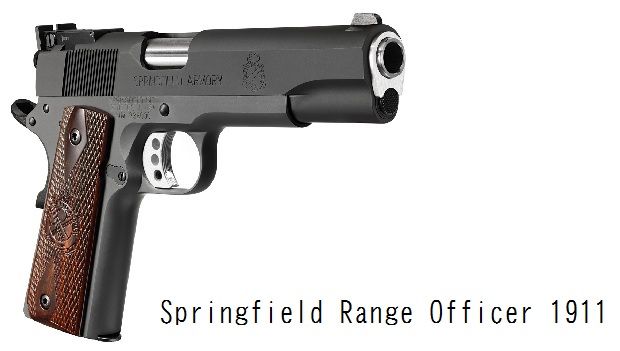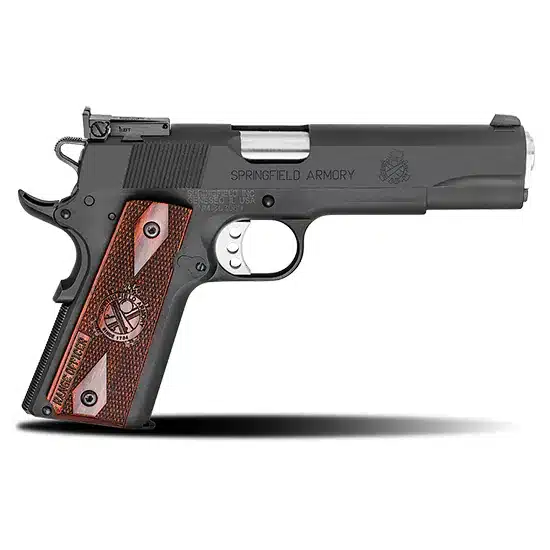It’s easy for those of us who love 1911s to “need” more than one. If you’re looking to step up in 1911 performance at the range without breaking the bank on a few thousand dollars worth of custom race gun, the Springfield Armory 1911 Range Officer might be right up your alley!
Full Review of the Springfield Armory 1911 Range Officer
This article will include a full review of the 1911 Range Officer and a full comparison of the RO to a Springer standard: the 1911 A1 Loaded.
1911 Range Officer Features
Grips
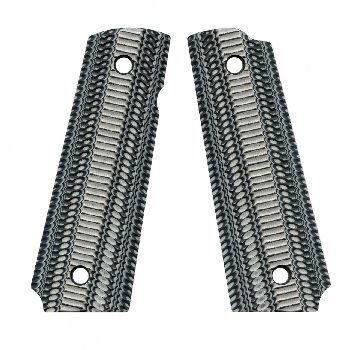
Out of the box, the Springfield Range Officer has cocobolo wood diamond checkered grips that feature the Springfield Armory logo. With these grip panels, the overall grip width measures 1.25 inches.
Through my research, as well as experience, I’ve found that the ergonomics of 1911 grips fit a wide range of hand sizes, from “daintier” lady-sizes, up to the meaty bear paws some fellas sport. And, if the standard cocobolo wood panels don’t suit your fancy, replacing them is a cinch.
There are a bajillion different options for full size 1911 grips out there from which to choose. The comfortable full size, rear strap checkered, high beavertailed grip with the Springfield Range Officer’s hefty 37.7 ounces makes the punch of .45 ACP ammo more manageable.
→ Best Grip Upgrades For Your 1911
Triggers
As one would expect from a Springfield 1911, the trigger pull is crisp and breaks cleanly after a short travel. My Lyman Trigger Pull Gauge measures the weight of pull at an average of 5lbs and 13oz.
A custom 1911 trigger job could lighten up that pull some, but, as is, it’s not bad for a production 1911. The Springfield Range Officer 1911 comes standard with a skeletonized trigger with a serrated face (a nice little upgrade when shooting with gloved or moist fingers).
→ Best Trigger Upgrades For Your 1911
Sights
Most of the 1911s I’ve shot have featured some sort of 3 dot sight configuration, so it took me some time to adjust to the Range Officer’s black notch/black blade sight picture. It didn’t help that I was shooting at a black bullseye, so if I didn’t focus enough, the sights and target had a tendency to kind of “blur” together. But, after a couple of mags, I learned where to hold for them and had no problems with being able to achieve accurate shots. They do take a hair more time to realign between shots than contrast sights (such as a three dot or fiber optic front sight), though. One of the perks of this Springer’s sights is that they are adjustable for elevation and windage.
→ Best Sights For Your 1911 Reviewed
Slides
The Range Officer’s slide is striated with cocking serrations at the rear. And while it doesn’t feature any front cocking serrations, I have no trouble actioning the slide with only the use of my thumb and two fingers. While racking the slide, I notice that it seems to ride snugly along the frame. This tightness of parameters, and the 5-inch match-grade barrel the slide houses, help contribute to the 1911’s increased accuracy (I’ll elaborate on that performance element in the comparison section below). The slide also has a lowered and flared ejection port, to help with reliable casing ejection.
Other Features
As a single stack 1911, the Springfield Range Officer is limited in capacity. The RO holds 7+1 rounds of .45 ACP, and two blued magazines are included in its case. During the course of my test and evaluation of the Range Officer, the blued finish on the mags has started to show a bit of wear, but I’ve had no issues with feeding, nor with magazines not dropping free when released.
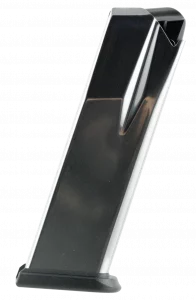
Springfield 1911s usually feature both grip and manual thumb safeties. I know there are some shooters who are quite passionately against grip safeties. However, as this pistol’s design and my purposes for it are for precision [competition] shooting, I don’t take issue with that feature; any time I use this gun, I have a firm grip.
The manual safety, however, is a slight point of contention for me. As a cross-dominant shooter, I find it an easier task to shoot single-handedly with my left, rather than my right. I can, and have, fired the RO lefty (as I demonstrate in the video above), but it makes it somewhat inconvenient that the thumb safety is configured for right-hand use only. The magazine release is also set up for right-handed operation, but it is reversible.
→ The Best 1911 Magazines for Your Money
Carry Considerations
The Springfield Range Officer 1911 was not designed for concealed carry, but for precision competition shooting. So, I’m not going to put a lot of focus on evaluating it for self-defense purposes. Where this pistol really shines is at the range. Personally, I wouldn’t try to “make it work” and carry the RO anyway, namely because of the sights. Adjustable target sights are less than ideal for CCW purposes, but they are a boon in the field of precision shooting.
→ The Best 1911 Handguns for Concealed Carry
→ The 8 Best 1911 Holsters for Your Money
Comparison: Springfield 1911 A1 Loaded
My father’s Springfield A1 Loaded was not only the first 1911 I shot, but also the first .45 caliber handgun I’ve ever fired. Over the years, I’ve put a few thousand rounds through it. So, it surprised me that after 6k-7k rounds through the A1 Loaded, and 600-700 rounds through the Range Officer, that I was able to be much more accurate with much less experience when shooting the Range Officer, see what I mean?
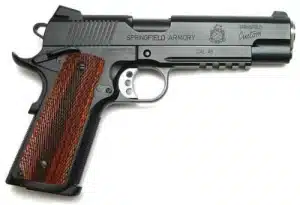
Aesthetically, the two 1911s I feature in the video with this post have different finishes and different grips. The A1 Loaded has a more “blingy” stainless finish compared to the more understated parkerized finish the Range Officer sports. However, if you prefer the parkerized finish, it is an option for the A1 Loaded. I like the look of the RO’s finish, especially with the cocobolo wood grips; however, it is not the hardiest finish I’ve seen. It is easily scratched.
Aesthetically, I lean toward the shiny A1 Loaded’s finish (and if it does get scratched, as most oft-used firearms do, it’s not as noticeable). The grips on the featured pistols are also different. Although, out of the box, both of these Springfield 1911s featured diamond checkered cocobolo wood grip panels. My dad has since swapped out his stock panels for a rubberized Hogue wraparound grip featured in the video.
Another notable difference between the Springfield Range Officer 1911 and the A1 Loaded is their sights. The featured A1 has fixed low profile combat 3 dot sights. And while the Range Officer’s adjustable target black notch/blade sights are the same height as the A1’s, they are straighter, less hardy, and more likely to snag. But, the loss of “combat ergonomics” is a result of having adjustable sights, and as a precision competition 1911, being able to compensate for windage and elevation with an easy sight adjustment is more valuable than conceal carry capabilities.

With regard to dimension, the Springfield Range Officer 1911 and the 1911 A1 Loaded are virtually identical. They both measure 8.5 inches long and 5.5 inches tall. While both feature 5″ barrels, the Range Officer’s is match grade and the A1’s is not. The weight of each is also comparable. I repurposed a food scale to measure each pistol and the unloaded A1 only tipped the Range Officer’s (unloaded) 37.7ozs by .3oz.
If I hadn’t weighed them, I wouldn’t have been able to tell the difference. The same goes for the trigger pull. My Lyman guage measured the averged the pulls for the A1 and the Range Officer at 5lbs 13ozs. Both 1911s share a few “bells and whistles,” as well. The Springfield 1911 A1 Loaded and Range Officers each feature loaded and flared ejection ports, skeletonized hammers and triggers, grip safeties, and manual frame mounted safeties.
Although, the A1’s thumb safety is ambidextrous, as opposed to the right hand only operated safety on the Range Officer. The 1911 A1 Loaded also has front and rear cocking serrations (the RO only has rear cocking serrations). The capacity for both pistols is 7+1 rounds of .45 ACP.
→ Full review Springfield Armory 1911: A1 Loaded vs. Range Officer here
Final Thoughts
Some of the things that make the Springfield Range Officer 1911 a great target pistol are the fact that it is a weighty 1911 with ample space for a full grip, and a couple of pounds to help “soak up” the recoil.
One of the biggest expectations I had for an entry-level competition 1911 was improved accuracy, and the Range Officer delivers. I’ve had a few years and a few thousand rounds of experience on my dad’s trusty Springer A1 Loaded. I have a good idea of the feel for how it recoils, the muzzle flip, and where to hold to be able to put rounds pretty much where I want them. But, it doesn’t compare to the Springfield Range Officer 1911’s performance. This thing is a tack driver.

